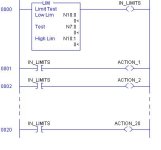The Plc Kid
Member
Guy's
I am doing some rs logix 500 programming in a slc 5/04 and i have to use a limit instruction on about 20 rungs. Same instruction and same values in each.
On the high and low limit i can put a static value my question is where is that static value stored? In the instruction or in a memory location not viewable?
From time to time this value will need to change and i do not want to change it 20 times.I can use a integer word and enter the value but is there ever any situation where this value may get lost somehow and the instruction have a zero for high/low limit.
I could make a rung to always move the values to the memory locations but i would like to avoid that unless it is necessary.
Just trying to make the code a little more simple or is it a best practice to jsut make a rung to move the value into the locations on first scan or something?
Whats best?
I am doing some rs logix 500 programming in a slc 5/04 and i have to use a limit instruction on about 20 rungs. Same instruction and same values in each.
On the high and low limit i can put a static value my question is where is that static value stored? In the instruction or in a memory location not viewable?
From time to time this value will need to change and i do not want to change it 20 times.I can use a integer word and enter the value but is there ever any situation where this value may get lost somehow and the instruction have a zero for high/low limit.
I could make a rung to always move the values to the memory locations but i would like to avoid that unless it is necessary.
Just trying to make the code a little more simple or is it a best practice to jsut make a rung to move the value into the locations on first scan or something?
Whats best?






